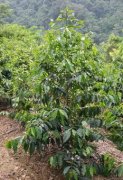The knowledge of the growth process of coffee beans the growth habits of coffee

Coffee is a kind of drink, which gives the public the impression that it is black, bitter, sleepless and excited. The coffee beans we see in the coffee shop are tea-brown, which belongs to roasted coffee beans, while the color of the coffee liquid is amber. Coffee comes from coffee beans, which are harvested and processed from the fruit of trees.
The growth habits of coffee:
Coffee trees belong to the evergreen family of Akanaceae. They are tropical plants that are not cold. Most of them are planted in areas with elevations of 300,400m, and also in highlands with elevations of 2000-2500 meters. But those who plant on slopes above 1500 meters above sea level have better quality. Coffee trees are most suitable for growing in an environment where the average temperature is about 20 degrees Celsius, annual precipitation is 1500-2000 mm, soil permeability is strong, and sunshine is suitable. Coffee is afraid of Frosts Descent and the cold winter, and must not be planted in the highlands where frost falls. Generally speaking, wild coffee trees can grow to about 8 meters. They are planted at home. In order to protect the quality of coffee beans, facilitate management and harvest, the height is cut to 2 meters. Coffee beans begin to bear fruit 3-5 years after sowing, and 5-20 years is the harvest period. A coffee tree can produce about 3-5 kilograms of coffee cherries per year.
Distribution of coffee:
Coffee trees grow in national gardens in tropical or subtropical regions with the equator as the center and between latitudes 25 degrees south and north, called the coffee belt. At present, coffee is produced in more than 60 countries, widely distributed in South America, Central America, the West Indies, Asia, Africa, Arabia, the South Pacific and Oceania. In terms of production, Brazil, which accounts for the largest output in the world, accounts for about 30%; the second is Central and South America, which is centered on Colombia (10%), accounting for 60%; followed by Africa and Arabia, accounting for about 30%; the remaining 10% are distributed in Asia and most islands.
(this article is reprinted)
Important Notice :
前街咖啡 FrontStreet Coffee has moved to new addredd:
FrontStreet Coffee Address: 315,Donghua East Road,GuangZhou
Tel:020 38364473
- Prev

The process of coffee planting: coffee trees, coffee flowers, coffee fruits
The coffee tree is an evergreen tree with small white flowers and green fruit that does not turn red until it is ripe. A normal coffee tree can usually grow to a height of 5 to 10 meters, but bean farmers often prune it to less than 2 meters for harvest convenience. After flowering, there are many dark green oval fruits, and the mature fruits change from dark green to bright red, due to the color and cherry.
- Next

The common sense of hand-brewed coffee with exquisite taste and aroma.
Wine, floral utensils, coffee walks every day is for seven flavors. [Qiwei Tangxinzi Coffee] the matter of making coffee by hand always makes me feel an awe-inspiring sense of ritual, as if waiting for sunrise as secretly excited, small and surging. . Maybe put it this way, a good cup of hand-made coffee taught me about slow refinement. Weigh the roasted fresh coffee beans
Related
- Beginners will see the "Coffee pull flower" guide!
- What is the difference between ice blog purified milk and ordinary milk coffee?
- Why is the Philippines the largest producer of crops in Liberia?
- For coffee extraction, should the fine powder be retained?
- How does extracted espresso fill pressed powder? How much strength does it take to press the powder?
- How to make jasmine cold extract coffee? Is the jasmine + latte good?
- Will this little toy really make the coffee taste better? How does Lily Drip affect coffee extraction?
- Will the action of slapping the filter cup also affect coffee extraction?
- What's the difference between powder-to-water ratio and powder-to-liquid ratio?
- What is the Ethiopian local species? What does it have to do with Heirloom native species?

